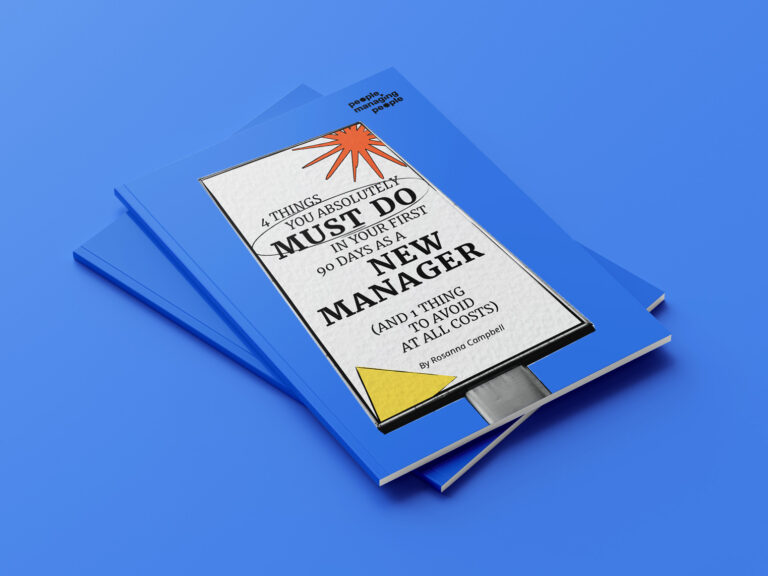Research shows that having friends at work makes you more productive, better at communicating, and happier in your job (maybe take a moment now to appreciate your work bestie).
But what about when one of you becomes the boss?
A study by the University of Reading found that 90% of first-time managers struggled with setting boundaries with employees, especially when they’d previously been friends. Nearly three-quarters of them said they lost friendships after becoming a manager.
So, if you’ve found yourself in this situation, how can you maintain your friendships, while still establishing your authority and setting healthy boundaries?
In this article, we’ll explore:
- What makes being your friends’ boss so difficult?
- How can you establish your authority with your co-workers as a new manager?
- How can you set boundaries with your friends–without losing your friendship?
Why is it So Hard to Go from Friend to Boss?
Jessica Kriegel, the Chief Scientist of Workplace Culture at Culture Partners, says that the transition from friend to boss is “one of the most awkward transitions in business.” The main issue is the change in power structures, Kriegel explains.
“What was a relationship of two equals becomes a relationship in which one friend is “above” the other—at least according to the hierarchical organizational structure.”
The other issue is what psychotherapists call the “dual relationship principle.” This is the concept that your therapist should never also be your friend, lover, colleague or family member.
The reasoning, explains Art Markman, a professor of Psychology at the University of Texas, is that “every relationship has goals associated with it, and when you have more than one relationship, those goals can conflict and cause serious problems.”
This isn’t just an issue for therapists. When you become your friend’s boss, then the goals for your friendship (connection, empathy, fun) may come into direct conflict with your goals for your professional relationship (such as offering direct feedback or promoting top team performance.)
Finally, if you have a personal relationship with one or more members of your team, then it can make it harder to build a connection with the rest of the team. You may find yourself accused of favoritism—or overcompensating for your friendship by being unduly harsh with your friends.
The secret to overcoming the awkwardness—and keeping your friendships—comes down to open communication and setting clear boundaries.
What Does It Mean to Be the Boss?

To set personal boundaries, you first need to understand what it means to you to be a manager. What kind of leader do you want to be? What work environment are you trying to create?
This level of self-awareness is key, both to being the best manager you can be, and for understanding the kinds of work boundaries you need to set with your co-workers.
When it comes to establishing authority, many new managers think they need to be an “autocratic leader”. They worry that they’ll need to start to order people around, and generally transmit the message “My way or the highway.”
However, there are many other models of leadership that can help you to establish authority, without turning you into General Patten. In fact, these approaches to management can make your personal relationships with your team into an advantage, not a problem.
Consider, for instance:
Servant leadership
Servant leaders aspire to put employee well-being first and support their team to achieve greatness. Instead of telling people what to do, they provide coaching and feedback. They aim to empower the people on their team, rather than micromanaging them.
Empathetic leadership
Empathetic leaders aim to understand first, and then react. They start with the principle that employees are individuals with a unique set of pressures and challenges. If you already have relationships with some of the members of your team, you have a head start when it comes to building trust and empathy within the team as a whole.
Authentic leadership
Again, if the people on your team already know you as an individual, as well as a colleague, you may find this leadership model comes naturally to you. Authentic leaders lead from their values, whether they’re interacting with their direct reports or making tough decisions. They are open and honest about who they are and what’s important to them.
As you can see, there are many models of management that will work well, even if you’re managing people who are also your friends. In fact, several approaches to leadership are going to be easier to achieve when you already have the trust of the people you work with.
How to Set Boundaries with your Work Friends
However, no matter what type of manager you aspire to be, you will still need to set boundaries with employees—especially if you have an existing friendship. If you don’t set healthy boundaries, you might find that you run into:
- Accusations of unfairness from direct reports who aren’t your friends;
- Work dynamics spilling into your personal life, causing unnecessary stress;
- Burnout, as you struggle to manage two types of relationship simultaneously;
- Extra work, as you try to do your job as a manager without hurting anyone’s feelings or causing friction with your friends.
Here are a few tips for setting boundaries at work:
1. Start by acknowledging the issue
Before you can begin to set professional boundaries, you need to start with a frank conversation with your friends. Recognize that you feel concerned about the impact of your new role on your friendship, and ask them how they’re feeling.
Markham explains that when you sit down with your friends and discuss the possible conflicts frankly, you can help them to see that the new dynamic is challenging for both of you. “You may assume that your friends will implicitly understand the tensions you have, but they are much more likely to be sympathetic if you have an open conversation.”
April Shprintz, now a business consultant and the founder of Driven Outcomes, found that being upfront about her own discomfort was the key to maintaining her work friendships. She recalls:
"I was promoted to lead a three-person team and two of the three were friends. I was both less experienced and less credentialed than each of them. Imposter Syndrome crept in and the fear that I would lose my friendships."
Instead of ignoring the issue, Shprintz sat down with her team and shared that she was feeling vulnerable. “I owned that I was the least experienced and youngest on the team and that I would need their help for us to be successful. In exchange for that help, I promised to be their biggest advocate and to lead with everyone's professional and personal goals in mind. Each member of the team got well deserved raises and nominations for company awards.”
2. Keep things professional
Behaviors that are acceptable when you’re an individual contributor are no longer appropriate when you become a manager.
For instance, venting about difficult colleagues or a company policy you don’t like is fine for employees. However, when you become a manager, you need to keep things more professional.
Your role now includes promoting a positive attitude and encouraging top team performance—and you can’t expect to do that job if you still gossip with your friends in the office.
Leadership coach and former S.W.A.T. Commander Eddie Mac explains, “To be successful, the leader must never waiver from the confines of their role for the sake of “friendship.” If so, other coworkers will see this as favoritism and weakness in the leader.”
In other words, while you might feel like the best way to keep your friendships going is to fall back into your old dynamics, in fact it’s better all round if you maintain emotional boundaries during work hours.
3. Define and communicate your boundaries
There are different types of boundaries involved in working with a team. Sit down with your team (including your friends) and agree on the kinds of workplace boundaries you all need.
You should decide on:
Communication boundaries
How do you all prefer to communicate about work? By Slack, by work email, by WhatsApp? When is it OK to communicate about work—only during work hours? How will you maintain your work-life balance?
Physical boundaries
This isn’t just a question of personal space (although if you and your friends are huggers, you might need to discuss if this is still appropriate).
You can collectively decide on working hours, how long breaks should be, whether or not it’s positive to leave the workspace to get fresh air and exercise during working hours, and so on.
Emotional boundaries
We tend to share emotions with our friends that we wouldn’t share with a manager or a direct report. You may need to decide with your friends (and the rest of the team) which aspects of your emotional life you want to keep sharing at work, and what you’d prefer to keep private from now on.
This will often depend on the overall company culture; for instance, in a company where employees are encouraged to bring their whole selves to work, emotional sharing may still be appropriate.
Time boundaries
If you don’t discuss time boundaries explicitly, your friends may expect to take up more of your time than you can afford to give them.
Managers are often extremely busy, especially in the early days–so times that you spent socializing with friends at work might not be available any more.
If you hope to maintain a healthy work-life balance, you’ll need to be clear with your friends and direct reports about when you’re available to chat, and when you aren’t.
Some managers use “office hours” (whether literal or virtual) to make sure they are available for their teams, while also having enough time for deep work.
4. Don’t play favorites
Research published in the Harvard Business Review found that consistency and fairness are key to building strong working relationships with your former peers.
For instance:
- Use a template or standard format for one-to-one meetings to ensure your friends and other direct reports get the same input and feedback. You can find a handy one-to-one agenda here.
- In your first 90 days as a new manager, set up a team meeting to discuss shared values and get to know one another. That way, you’ll start to know as much about your other direct reports as you do about your friends.
- Be inclusive. For example, if you invite your friends to join you for lunch, make sure you open up the invitation to the rest of the team too. The researchers found that half of their respondents developed new friendships with their direct reports by sharing social time together.
- Be transparent. For instance, if you’re used to exchanging off-topic messages with your work friends via Slack, open up your Slack channel to the rest of the team as a place for watercooler chat. That way, you make sure nobody feels left out and create a more unified team dynamic.
- Use performance management and employee recognition tools to avoid unconscious bias towards your friends. Even with the best will in the world, we can all fall victim to unconscious bias. We may not even notice that we’re giving more recognition and praise to the people we know better.
Using standardized performance management software can help. Researchers at Stanford VMware Women’s Leadership Lab found that, when a performance management system forced managers to be specific and provide evidence for their feedback, it dramatically reduced rater bias and created a fairer work environment.
Setting boundaries with employees comes down to open communication
It can be awkward to set boundaries at work–especially with your friends.
However, the best way forward is to communicate openly about your own needs and concerns, and listen attentively to what your friends need and how they’re feeling. Then, you can work together to decide on the workplace boundaries that work for both of you.
Talking about your own boundaries can feel uncomfortable, but frank conversations are at the heart of a healthy workplace.
Some further resources to help you become a great manager:
- How To Handle Awkward And Uncomfortable Conversations: What Every New Manager Should Know
- The 15 Best Personal Development Podcasts of 2024
- In Too Deep: How To Keep Calm & Carry On When You’re Overwhelmed As A New Manager
- 11 Leadership Models To Help You Become A Better Leader
- How To Create Psychological Safety In The Workplace (with Sarah Wirth from EcSell Institute)

The New Manager Handbook
Hard-learned words of wisdom from seasoned people managers to those just starting out.


